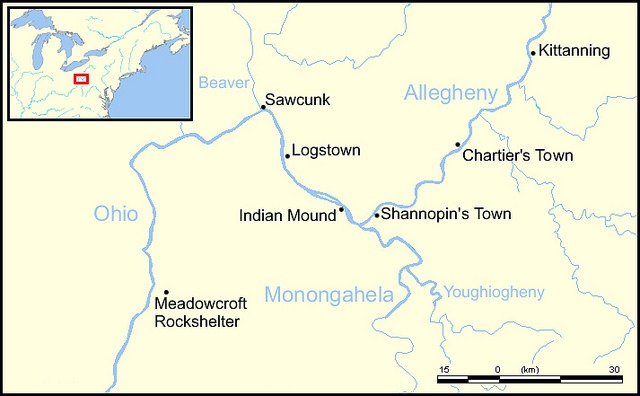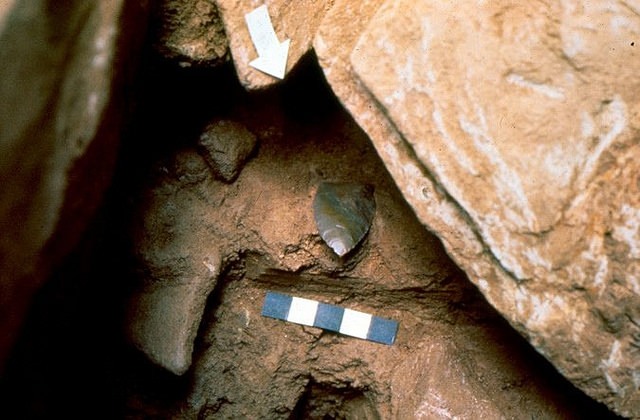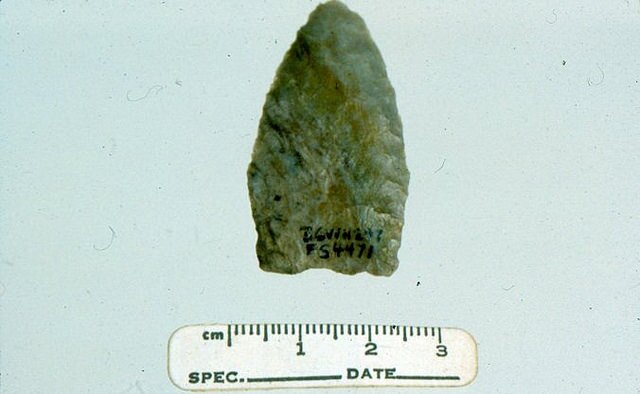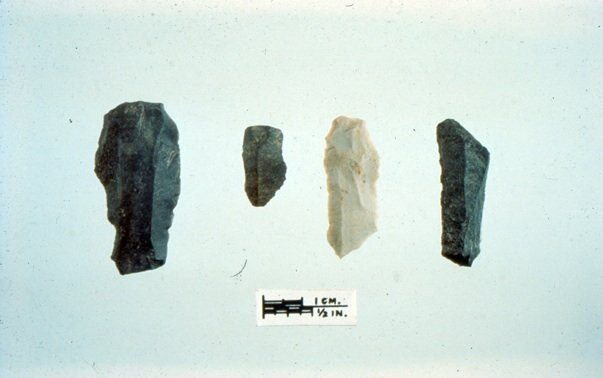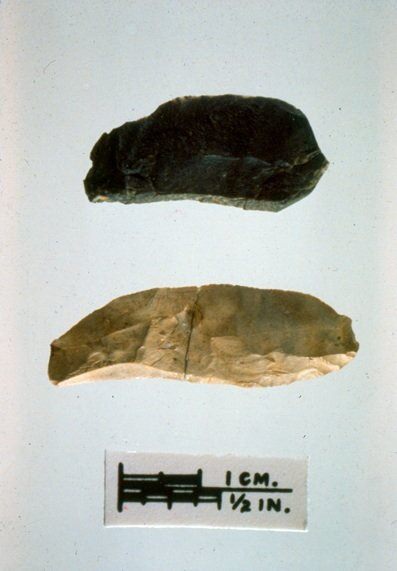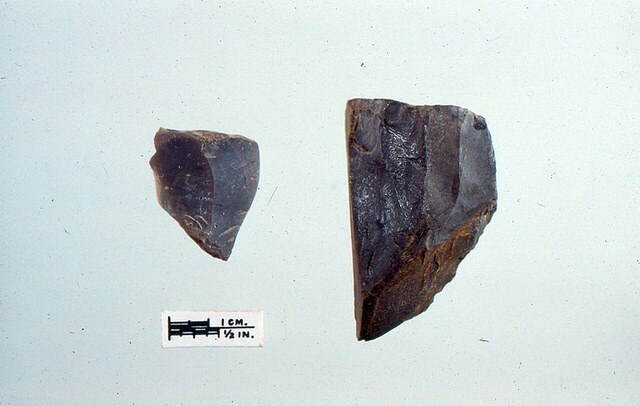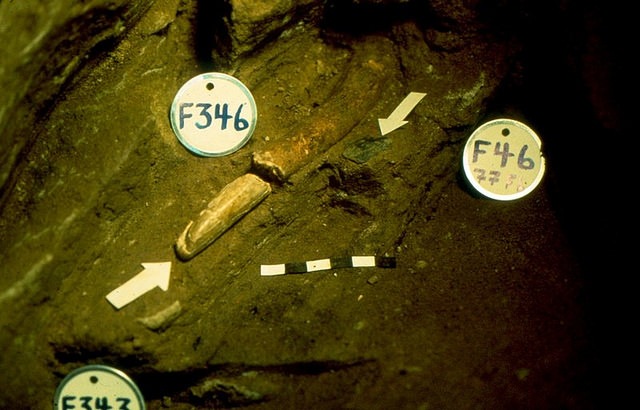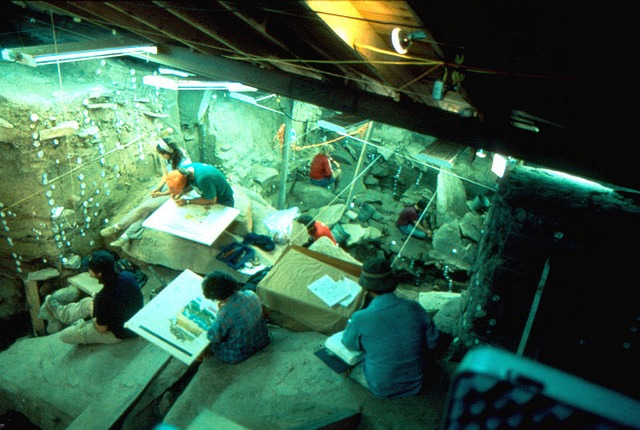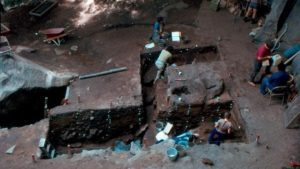
Peering up at it from below, I could see that this wouldn’t be a leisurely stroll. This flight of seemingly countless steps, ascending with rails almost like scaffolding to a destination high above, invited a small sense of adventure. But I could envision that, long before this modern, convenient construction, human visitors surely had a more challenging task. I was told that casual visitors once had to ascend with the aid of a rope assemblage, and long before that, Native Americans had to reach it using whatever devices or efforts at their disposal. Carved by nature in a bluff overlooking a tributary of the Ohio River known as Cross Creek, the ancient rockshelter above had remained tucked away for millennia within a lush green, hilly landscape of what is today called the Allegheny Plateau of western Pennsylvania. Thousands of years of weathering and erosion made this place a cave-like shelter for prehistoric human sojourners—affording them protection from the elements without and a space to rest, sleep and eat within.
Once I reached the top of the steps, I could move freely over a spacious, human-made platform, designed to hold small capacity crowds. I could now see the interior of the rockshelter clearly laid out before me, left as it was after the latest archaeological excavations closed out (although the site continues to be investigated). But long before archaeologists and others came to investigate and work at the site, nature’s hand had already morphed its appearance many times over through thousands of years of weathering and erosion. I could see the visible reminders of this in the face of the sandstone cliffs surrounding it. Slowly sculpted by water, wind and ice, it was an almost surrealistic picture of what time and the elements could do to otherwise seemingly impermeable and impenetrable stone. Today, the rockshelter is enveloped in an impressive, protective overhanging wooden construction, an architectural wonder by itself.
Archaeologists, historians and the public call this place Meadowcroft. For those who know something about the site, the Meadowcroft rockshelter is now widely thought to have yielded evidence of the earliest known presence of humans in North America, along with the longest sequence of continuous human occupation. It was first systematically excavated by Dr. James M. Adovasio, currently the Dean of the Zurn School of Natural Sciences and Director of the Mercyhurst Archaeological Institute at Mercyhurst University. His efforts included a team of colleagues and field school students in the early 1970’s. All together, they uncovered evidence of a human presence they suggested dated thousands of years before the time of the advent of the first broadly recognized human culture in the Americas—the Clovis—and its implied first peopling of the North American continent. Their dating at this site pushed the clock back on human occupation of North America to as much as 16,000 years ago.
But this stature and acceptance didn’t come quickly and easily for Meadowcroft and its chief archaeologist. It challenged the prevailing paradigm, radically pushing back the dates on human occupation of the continent. From the very beginning, the validity of his findings related to the earliest human modified stone objects and other features of human habitation found at the site were marked with controversy. Decades later, however, the story of the Meadowcroft controversy has evolved to one of broad acceptance. Partly due to the mounting evidence from other sites with Pre-Clovis artifacts across the Americas, and in no small measure to the meticulous and scientifically rigorous methods used in the Meadowcroft research, the site has arguably become a kingpin in a new mainstream of scientific inquiry that has increasingly legitimized the ‘Pre-Clovis’ way of thinking. Today, Meadowcroft is designated as a National Historic Landmark, drawing thousands of visitors yearly. — Ed.
_____________________________________________
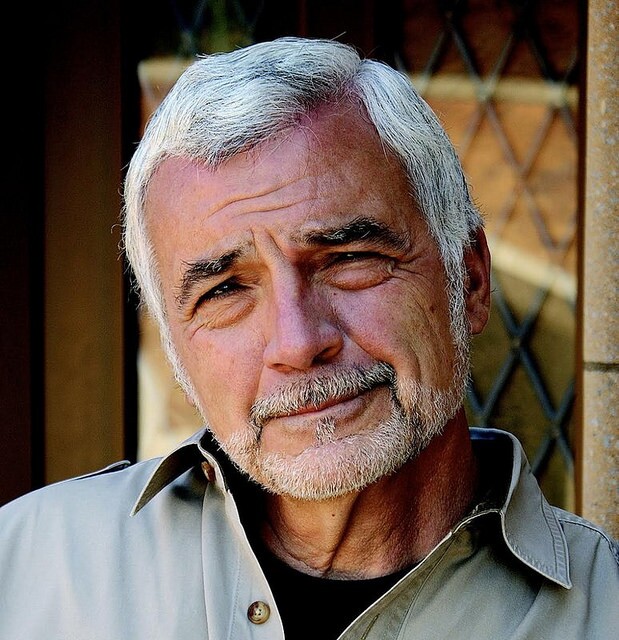 Popular Archaeology took the opportunity to interview Dr. Adovasio (pictured right) about the site and its significance within the context of the ongoing search and debate on the first peopling of the Americas. What follows are the details of that interview:
Popular Archaeology took the opportunity to interview Dr. Adovasio (pictured right) about the site and its significance within the context of the ongoing search and debate on the first peopling of the Americas. What follows are the details of that interview:
Q1: Would you describe your personal route/experience, attributes and interests that drove you to your current occupation or career?
As I indicated in my book, “The First Americans,” I was essentially programmed to be an archaeologist by my mother, Lena M. Adovasio. She was a four-field major in college, one of which was history and another of which was chemistry. She taught me to read well before kindergarten with geology, paleontology, and archaeology books. As a consequence I never really wanted to do anything else except pursue an archaeology career. I knew where I wanted to go to undergraduate school in the 6th grade and, in fact, attended that institution (The University of Arizona). The attributes which I brought to the “archaeology table” were and remain, extreme attention to detail, a high degree of organization leavened with intense self-discipline, and, I suppose, the ability to absorb and synthesize oftentimes very diverse data sets. It probably helped that, like my mother, I was endowed with a near perfect memory.
Q2: What is the story of how Meadowcroft first came to your attention?
When I assumed a faculty position at The University of Pittsburgh in 1972, I was told that one of the parameters of that position was the establishment of an archaeological and geoaracheological field training program in western Pennsylvania. What I had hoped to locate was an area with little or no previous archaeological or geoarchaeological research coupled with relatively easy striking distance of Pittsburgh for obvious logistical reasons. I also sought an area which contained at least one cave or rockshelter site because these were the sites I was most familiar with from my graduate career at The University of Utah. Because I had previous research commitments on the Island of Cyprus in the eastern Mediterranean, I did not have the time to locate a suitable study area myself. So I circulated word amongst my colleagues in the profession, and as a result, a now deceased historian/amateur archaeologist from what was then California State College, California, Pennsylvania, informed me about Meadowcroft Rcokshelter in the early spring of 1973. His name was Phil Jack, a longtime friend of the landowner, Albert Miller, who discovered the site. I arranged with both of them to visit the site in the later spring of 1973 and upon viewing it decided to solicit permission from the landowners to begin excavations there in June of 1973. The rest is, literally, history.
Q3: While excavating at Meadowcroft in the 1970’s, what was it that made you realize that there was something special or unusual about this site?
We initially believed that the deposits at Meadowcroft would be something less than a meter in thickness and that the oldest occupation would be Late Archaic or Early Woodland, at best. These estimates were based on excavations at other rockshelters in southwestern Pennsylvania and adjacent portions of Ohio and West Virginia. However, early in the 1973 season it became clear that the deposits at the site were well in excess of a meter in thickness and the recovery of Middle and Early Archaic materials signaled an older occupation than we had imagined. Of course, when the first radiocarbon dates were run after the 1973 season was over, it was evident that the site was initially occupied earlier than we suspected.
___________________________________________
General view of Meadowcroft Rockshelter facing west before excavation in 1973; vegetation marks the limits of the vegetation current overhang; large block in lower left represents a roof detachment ca. 12,500 years ago. Image courtesy James M. Adovasio
____________________________________________
Q4: What finds convinced you that you had uncovered evidence of human occupation at this site going back possibly 16,000 years or more?
The answer to this question is more complicated than it seems. The deposits at Meadowcroft are characterized by a series of roof spalling and block collapse events which dramatically altered both the configuration of the rockshelter, as well as the availability of “livable” floor space through time. One such spalling event marks, in effect, the Pleistocene-Holocene boundary as well as, for all intents and purposes, the end of the Clovis interval in southwestern Pennsylvania. Beneath this spalling event, we expected to encounter no additional, older cultural material, but rather the parent bedrock of the rockshelter in the form of the Birmingham Shale. Instead of the Birmingham Shale, we found a series of apparent occupational surfaces replete with shallow fire pits and associated artifacts of indisputable anthropogenic origin. Radiocarbon dates derived from charcoal within these pits clearly preceded the established age of Clovis in eastern North America, thereby, and surprisingly to us, indicating an earlier than Clovis occupation. Additionally, none of the recovered artifacts, most notably the unfluted lanceolate so-called Miller projectile point [named after the site’s discoverer] and small blade flakes, were consistent with a Clovis ascription.
_____________________________________________
Lithic shown under rockfall is the type specimen of the Miller Lanceolate projectile point form. Courtesy James M. Adovasio
___________________________________________________________
Miller Lanceolate projectile point type specimen, obverse surface; the specimen is significantly re-sharpened and reduced in overall dimensions from the hypothesized prototype; it is unfluted, but basically ground. Courtesy James M. Adovasio
____________________________________________________________
Assorted Miller Complex artifacts from Stratum IIa (containing the oldest cultural remains radiocarbon dated to about 16,000 years B.P.) at Meadowcroft Rockshelter; from left to right: Miller Lanceolate type specimen made of local Cross Creek chert, prismatic blade flake made from Onandaga chert, prismatic blade flake made from Flint Ridge chert, biface fragments made from Flint Ridge or Kanawha chert (black specimens are Kanawha). Courtesy James M. Adovasio
__________________________________________________________
Q5: What is the significance of these findings within the context of the Clovis First debate?
Meadowcroft was the first site in nearly 40 years to seriously challenge the long held Clovis-First paradigm. Between 1933 and 1973, more than 500 archaeological sites in North and South America were claimed to be older than the Clovis horizon of ca. 10,900 to 11,300 uncorrected radiocarbon years ago. Prior to Meadowcroft, all of these Pre-Clovis claimants exhibited a similar history. First, you would read about them in a local newspaper or popular scientific journal, then more extensive treatments would appear in the technical scientific literature. Inevitably, the sites would then be exposed for some real or imagined flaw – the artifacts were not definitively of human origin; the stratigraphy was non-existent or imperfectly defined; the context and association of even genuine recovered artifactual material was problematic, etc. As I pointed out in “The First Americans,” each of these sites enjoyed a Warholesque 15 minutes of fame, then disappeared into oblivion. Each time one of these claimant sites failed, it reinforced the Clovis-First model. Therefore, by the time the initial reports on Meadowcroft appeared, there was a long established record of failure which served to render the Meadowcroft discoveries suspect ab initio.
Q6: Do you think the Clovis First paradigm is now discredited, or on its way out, given the findings from other sites across the Americas that show evidence of human occupation before Clovis times? (In other words, do you think there is sufficient evidence now to support a pre-Clovis presence or culture in the Americas, and why?)
To answer this question, it is perhaps useful to cite an observation by Dr. Jonathan C. Lothrop in his review of a Pre-Clovis site in the Americas, a volume published by the Smithsonian Institution. He says,
“In 2015, if one polled New World archaeologists familiar with the literature, I suspect most would agree that there is a growing body of evidence of human occupation in the Americas that pre-dates ca. 13,200 Cal. B.P.” (Lothrop 2015: p. 256)
I certainly concur with Lothrop’s assessment, but it is also worth stressing that a handful of very vocal, Clovis-Firsters still remain and, like Hrdlicka in an earlier time, will probably go to their graves with their minds unchanged. The death of established paradigms often takes a very long time—as witnessed, for example, by the many decades which elapsed between the promulgation of continental drift and its widespread acceptance in the geological community. I completely underestimated how long it would take for Clovis-First to expire and I also misjudged the degree to which its “spear carriers” would hold on to their beliefs. This is all particularly interesting given the fact that, almost from its inception, most European scholars and virtually all South American scholars questioned the underpinnings of the Clovis-First model. The American response, of course, was that the Europeans were simply ignorant of the facts and that the South Americans didn’t even publish in English. The number and distribution of what might be called broadly acceptable Pre-Clovis archaeological sites now clearly points to an earlier than Clovis presence. I stress, however, that even if there were only one, then one would be sufficient. Monte Verde effectively terminated the argument even if its still vocal critics don’t accept the fact.
________________________________________________
Blade flakes from Stratum IIa at Meadowcroft Rockshelter; cross sections range from prismatic on the first three specimens to triangular on the forth; the edge is intentionally dulled for hafting. Courtesy Jame M. Adovasio
___________________________________________________________
Bifaces from Stratum IIa at Meadowcroft Rockshelter. Courtesy James M. Adovasio
________________________________________________________
Close up of blade flakes from Meadowcroft Rockshelter; one edge of each blade flake is intentionally dulled for hafting, while the opposite edge is the working edge. Courtesy James M. Adovasio
____________________________________________________________
Polyhedral blade cores of the type from which Meadowcroft blade flakes were struck; these are very different from Clovis blade cores. Courtesy James M. Adovasio
________________________________________________________
Fractured punch made of antler and truncated blade flake lying upon a 13,500 year old surface. Courtesy James M. Adovasio
__________________________________________________________
Q7: What were the specific challenges of excavating and investigating the site?
All cave and rockshelter sites around the world are part of what some archaeologists call the “marked landscape”. Places so designated were well known to aboriginal populations both in time and through time and as such, were frequently visited and utilized. While some of these sites probably witnessed yearly visits, many were only episodically visited. Because of repetitive visits, often over very long periods of time, such sites provide the opportunity for studying environmental change and concomitant human adjustments to those changes in very unique ways. Unfortunately, depending on the nature, intensity, and duration of these visits, these types of sites may evidence considerable anthropogenic disturbance with attendant difficulties in establishing the stratigraphic/occupational sequence. Additionally, because of the nature of the depositional process in many of these sites, even without human disturbance, the stratification may be remarkably complex. The combination of naturally complicated stratigraphy and repetitive human visits with attendant disturbance render the proper excavation of these kinds of sites very difficult.
Q8: What specific techniques, processes, methodologies and applications made the investigation of this site stand out from other excavations or investigations?
A necessary preamble to this answer is to state that a field archaeologist in virtually any setting – prehistoric, historic, or forensic – has three basic responsibilities. The first, and most fundamental of these, is the reconstruction of stratigraphy from visible stratification. While in English, we tend to use the terms “stratigraphy’ and “stratification” interchangeably, they do not, in fact, mean the same thing. Stratification is an objective phenomenon. It has both subjective and objective physical properties which can be detected, assessed, and measured. Stratification is a product. Stratigraphy is both the process by which stratification is created and the study of that process. The establishment of stratigraphy from observable stratification is fundamental and critical to the other two responsibilities of a field archaeologist. Without it, the other two cannot be done. The second responsibility is the delineation of context. Context literally means place in time and space and unless the context of all recovered material is explicitly defined in a stratigraphic perspective, there is no context. Finally, perhaps the most difficult field responsibility is the demonstration of association. Association means that two or more items have entered the archaeological record penecontemporaneously as a consequence of the same process. Association refers, in forensic terms, to primary or probative evidence as opposed to secondary or circumstantial evidence.
Suffice to note, for reasons already articulated, it is particularly and peculiarly difficult to execute the three responsibilities of a field archaeologist in a cave or rockshelter situation. To execute these responsibilities in any excavation situation requires knowledge of and the ability to operationalize all of the so-called laws of stratigraphy. While most people are familiar with the first of these laws – superposition – many are, to varying degrees, unfamiliar with the remainder. These include original horizontality, lateral continuity, and intersecting relationships. The key to operationalizing all of these principles – frequently referred to as Steno’s Laws – requires the ability to recognize and delineate the contacts or interfaces between discrete strata. Without digressing into an arcane lecture on methodology, it should be noted that during the Meadowcroft excavations much of our attention was directed precisely at facilitating and defining interfaces and contacts. Students were exhaustively trained to recognize strata differences on the basis of perceived textural differences. In practice, this meant that they could use their trowels to detect differences in compactness versus friability, density versus porosity, and related properties by feel and even sound. Once sufficiently skilled, our students could recognize stratigraphic differences quite literally with their eyes shut in much the same way that anyone could detect by feel and sound alone the difference between layers of cake and icing between those layers. Despite the reliance on texture in the excavation training process, a wide array of other things were done to maximize the ability to “see” stratigraphic transformations in profile. Meadowcroft, virtually from the outset, was fully electrified and thanks to University of Pittsburgh engineers in conjunction with assistance from Westinghouse, we were able to install an experimental lighting system that allowed the excavators to combine different light sources to illuminate stratigraphic profiles in a variety of ways. The difference between different light source combinations was and is striking and, at that time, had not been employed extensively as a supplement to excavation.
In order to systematically plot the three-dimensional Cartesian coordinates of artifacts and ecofacts, a series of vertical and horizontal datum points were combined, initially manually, and later, via total stations, to ensure the establishment of the appropriate provenience or context of excavated materials. Since the rockshelter had an active phone line, we could then communicate directly via telephone modem to the mainframe at the University of Pittsburgh to encode excavation data. To my knowledge, this is also the first time that was ever done – at least in a cave or rockshelter setting.
In order to provide objective verification of what were subjectively defined strata, samples of sediment from each stratum or microstratum were processed with a Coulter blood cell counter converted to measure sediment size differences. Once again, this was the first time such technology had been employed in the field.
I could continue in this vein, but the point here is simply this – given the experience and imagination of the investigators, coupled with sufficient funding, we were able to implement a variety of data recovery and documentation as well as analytical protocols which had never been extensively employed before. While some of these did not work as expected, many did. The collective effect was a level of precision in the excavations which virtually no critic of the site has ever questioned.
______________________________________________
Precision and care: Excavation of a thin anthropogenic surface at the site via single-edged razorblade. Courtesy James M. Adovasio
___________________________________________________________
Above and below: On-site documentation procedures at Meadowcroft Rockshelter; colored pencils which represented different combinations of silt, sand, and clay-sized materials were employed to produce microstratigraphic profile maps of all parts of the excavation. Courtesy James M. Adovasio
_______________________________________________________________
Q9: What arguments or issues did you have to address regarding the validity of the finds and their dating?
Virtually from the publication of the first radiocarbon chronology from Meadowcroft in 1974, the possible age of the earliest occupation of the site engendered great controversy. Significantly, especially as compared to other putative Pre-Clovis claimant localities, none of this controversy surrounded either the excavation methodology employed at the site nor the possible anthropogenic origin of any of the earliest artifacts. As already noted, the excavations at Meadowcroft were, and still are, widely hailed as “meticulous” and the “early” artifacts bear the unmistakable stigmata of humanly modified materials. Instead, the criticisms of the possible antiquity of the site pivoted around three basic issues: 1) the possible particulate or non-particulate contamination of only the eleven oldest radiocarbon samples from the site; 2) the absence of Pleistocene faunal remains; and 3) the apparently anomalous character of the recovered floral materials.
Dozens of pages of published material have been devoted to refuting the objections to the apparent age of the lower and middle Stratum IIa materials from Meadowcroft and these arguments will not be repeated here. It should be sufficient to note that there is absolutely no probative evidence for the particulate contamination of any of the eleven oldest C-14 samples from Meadowcroft. As to non-particulate contamination, the introduction of dissolved older carbon into just the eleven deepest radiocarbon samples from Meadowcroft requires a vehicle for contamination in the form of groundwater movement. An intensive micromorphological study conclusively demonstrated that such movement did not occur and, therefore, the non-particulate contamination issue is moot.
As to the faunal and floral critiques, modern research indicates that the paleoenvironment south of the glacial ice front in North America was remarkably variable and diverse. Further, the floral species represented at Meadowcroft were not inconsistent with such diversity. Finally, the faunal remains from Meadowcroft’s oldest deposits are diminutive both in numbers and weight, though all of the species represented have been reported in Late Pleistocene contexts elsewhere in eastern North America.
Put most simply, all of the currently available data suggests that Meadowcroft was sequentially and sporadically visited before the advent and spread of Clovis technology by populations who may or may not have been the ancestors to the makers of fluted points.
Of course, a larger issue, at least for some scholars, was the absence for a period of time of “other Meadowcrofts.” Now, of course, there are other sites of demonstrable Pre-Clovis age. Despite the best efforts of diehard Clovis-Firsters to discredit these other localities, often with incredibly convoluted and far-fetched scenarios, the existence of Pre-Clovis populations in the new world is now widely accepted.
Meadowcroft set the evidentiary bar! Monte Verde broke it! Other sites are appearing to join them. For Clovis-First it is the end of the game.
Q10: If you were to create a scenario or story describing the nature and lifestyle of the early, Pre-Clovis inhabitants of the site, what would it be?
As described in various publications, the earliest visitors to Meadowcroft appear to have been broad spectrum foragers rather than megafauna-focused big game hunters. These populations visited the site, as would their successors, principally in the fall of the year, utilizing a durable technology that included the production of unfluted lanceolate projectile points and the manufacture of diminutive blade flakes from polyhedral cores. They also employed a perishable technology that included basketry and presumably a variety of other less well documented related technologies. Their visits to Meadowcroft were apparently brief and perhaps separated by a number of years. They exploited a wide array of lithic raw material sources which I personally do not believe reflect their range. I would suspect these materials were acquired by trade and exchange. These sources include Kanawha chert from West Virginia, Onandaga chert from New York, and Flint Ridge chert from Ohio to name but a few. Evidence of these earliest visitors to Meadowcroft, named by us the Miller Complex after Albert Miller who discovered the site, are also evidenced at several other localities in the Cross Creek Drainage and a very similar durable technology is also evident at more remote locations like Cactus Hill in Virginia. While there are no obvious technological connections between Miller durable technology and Clovis, there is the possibility that some sort of relationship may be discovered in the future.
_____________________________________________
Reenactment of Paleoindian family unit showing both genders, different ages, durable and non-durable technology. Courtesy James M. Adovasio
____________________________________________________________
Q11: What is in store for the future investigation and research of this site?
About one third of Meadowcroft remains unexcavated. This area is available for future study when there are even more resolute excavation, documentation, and analysis protocols available. The main task at present is to complete the long overdue final report as well as a series of smaller contributions about one or another aspect of the long Meadowcroft sequence.
Q12: Are there any other comments you would like to make?
The Meadowcroft/Cross Creek operation was originally designed as an undergraduate and graduate training project aimed at both anthropology/archaeology students and those in related fields. Obviously, there was also a research component but this was, at least on paper, secondary to the student training goal. Because of the experience of the multidisciplinary research staff as well as access to extraordinary funding, it was possible to not only offer students state-of-the-art protocols in site excavation, documentation, and analysis, but also to constantly refine those protocols from both a methodological and substantive perspective. Because of the foregoing, the excavations at Meadowcroft were considered by others to be at the very cutting edge of the field. That they are still considered by many to be so is a testimony to the success of the methodological aspect of the project. We have always been more proud and pleased with the methodological “end” of the Meadowcroft project than any, or even all, of the results it produced. Expanding the envelope of the field in any perspective is rewarding, but in terms of actual enhancement of field data collecting procedures, it is and has been particularly gratifying. From a more substantive perspective, while the earliest materials from Meadocroft have garnered the most attention, the incredible length of the occupational sequence is to us far more striking. Because of the lengthy and hyper-detailed Paleo-environmental record from Meadowcroft, we can examine macro and micro climatic changes and their attendant consequences very precisely. We can also articulate in unique ways human responses and adjustments to those changes. That was in essence the “cake” we were trying to bake. That the site proved to be quite old was the unintended “icing.”
For more information about the Meadowcroft Rockshelter and other related attractions at the site, see the website, Meadowcroft Rockshelter and Historic Village.
____________________________________________
Visiting the Site
I must admit that I lived a full three years less than a two-hour drive away from the Meadowcroft Rockshelter site before actually seeing this site in person. Likely many thousands more are not even aware that this, clearly one of the most important archaeological sites related to Early Americans, sits so closely to their doorsteps. Accessing the impressively well maintained site and its associated visitation area is, however, not a simple and straightforward endeavor. It isn’t located conveniently off the well-traveled freeway circuits. But the driving directions provided at the website can be extremely helpful to any first-time visitor. Any visitor should be aware in advance that, to physically access the rockshelter itself, one must ascend a relatively lengthy flight of stairs. But this effort, though comparatively modest as hiking and climbing goes, is richly awarded with an up-close-and-personal view of the site and its scenic surrounding context.
—Ed.
_______________________________________________
General view of Meadowcroft, facing northeast after sunset. Courtesy James M. Adovasio
_______________________________________________
Subscribe to Popular Archaeology Premium. Available to all laptops and mobile devices, and still the industry’s best value at only $9.00 annually.
___________________________________________
Travel and learn with Far Horizons.
____________________________________________
This richly illustrated issue includes the following stories: Recent findings shedding new light on the whereabouts of the remains of Philip of Macedon, father of Alexander the Great; how an archaeologist-sculptor is bringing bones of the dead back to life; archaeologists uncovering town life at the dawn of civilization; an exclusive interview with internationally acclaimed archaeologist James M. Adovasio about what makes the Meadowcroft Rockshelter prominent in the ongoing search for the first Americans; what archaeologists are finding at the site of the ancient city of Gath, the home town of the biblical Philistine giant, Goliath; and how scientists are redrawing the picture of human evolution in Europe. Find it on Amazon.com.

